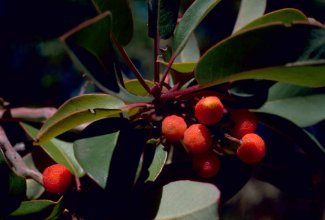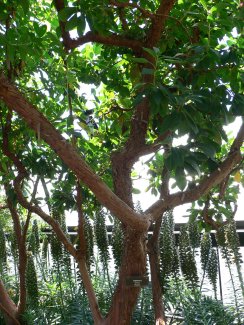Introduced to the nursery trade in the mid-1980’s, and no one is exactly sure where it originated, although theories abound. It is likely a cross between two other Arbutus, one of which is itself a hybrid of Arbutus unedo. Members of the genus are called madrones or madronas in the United States, from the Spanish name madroño (strawberry tree). In Canada--in British Columbia, where the species is common--arbutus is commonly used or, rarely and locally, "tick tree." All refer to the same tree, Arbutus menziesii, native to the Pacific Northwest and Northern California regions. It is Canada's only native broadleaved evergreen tree. Marina Strawberry Tree, unknown parentage although Arbutus unedo variety rubra is undoubtedly one of the parents. It is also likely that either or both of A. canariensis and A. andrachne conferred not only structural size but leaf size and smoothness of bark. The parent species likely experienced different blooming times, as the hybrid blooms nearly continuously and sets copious fruit.
A hybrid of uncertain parentage growing 25 - 40 ft. tall with dark green leathery leaves that have a red blush to the new growth. Arbutus ‘Marina’ was introduced into the nursery trade in the mid-1980’s, and no one is exactly sure where it originated, although theories abound. It is likely a cross between two other Arbutus, one of which is itself a hybrid of Arbutus unedo. Members of the genus are called madrones or madronas in the United States, from the Spanish name madroño (strawberry tree). In Canada--in British Columbia, where the species is common--arbutus is commonly used or, rarely and locally, "tick tree." All refer to the same tree, Arbutus menziesii, native to the Pacific Northwest and Northern California regions. It is Canada's only native broadleaved evergreen tree. While A. ‘Marina’ is a relatively tall tree – mature specimens can reach 40’ – it is a slow grower, so appropriate for all but the tiniest gardens. It has upright branches covered with smooth mahogany-colored bark, which exfoliates in late summer to expose the next year’s cinnamon-colored layer below. The dark green leathery leaves are about 4-5” long with flushes of bronze-colored new growth from spring through summer, which add interest and lighten the look of the tree. Even without the flowers and fruit, A. Marina is a handsome eye-catcher – it works well as a specimen tree as well as part of a group. Its pendulous clusters of small white and pink flowers are at their showiest in fall and winter, and are followed by yellow to red fruits. The fruit from last season remains on the tree as it produces this season’s flowers (similar to citrus), and both are displayed to advantage against the glossy leaves. The fruit is also edible with a flavor likened to a mixture of kiwi fruit and strawberry but as with the fruit of the common strawberry tree, Arbutus unedo, the texture is gritty. It is a good habitat planting, as both birds and bees enjoy the tree, the former feeding on the fruit, and the latter on the nectar. It is a native-looking but not a California native tree that is increasingly planted in situations that would seem to require a truly small tree.
A.‘Marina’ was introduced into the nursery trade in the mid-1980’s, and no one is exactly sure where it originated, although theories abound. One site indicates the following: "The origins of arbutus marina’ are told in an information sheet from Saratoga Horticultural Foundation Inc., the nursery that introduced it to the trade in 1984. It says that they propagated it from a 40-foot tall tree in a private garden in San Francisco. The name marina commemorates the location of Western Nursery on Lombard Street in the 1930s where cuttings were rooted from plants that probably were imported from Europe for the 1917 Exposition. A. marina is thought to be a hybrid of related arbutus varieties originating in Europe, and more closely related to the strawberry tree (Arbutus unedo) than it is to the madrone." Another site indicates that "the exact heritage of the A. “Marina” strawberry tree is unknown and confused by natural hybridizations between Old World species; it may spring, for example, from A. x andrachnoides, the naturally occurring cross of A. unedo and A. andrachne, the Greek strawberry tree."

